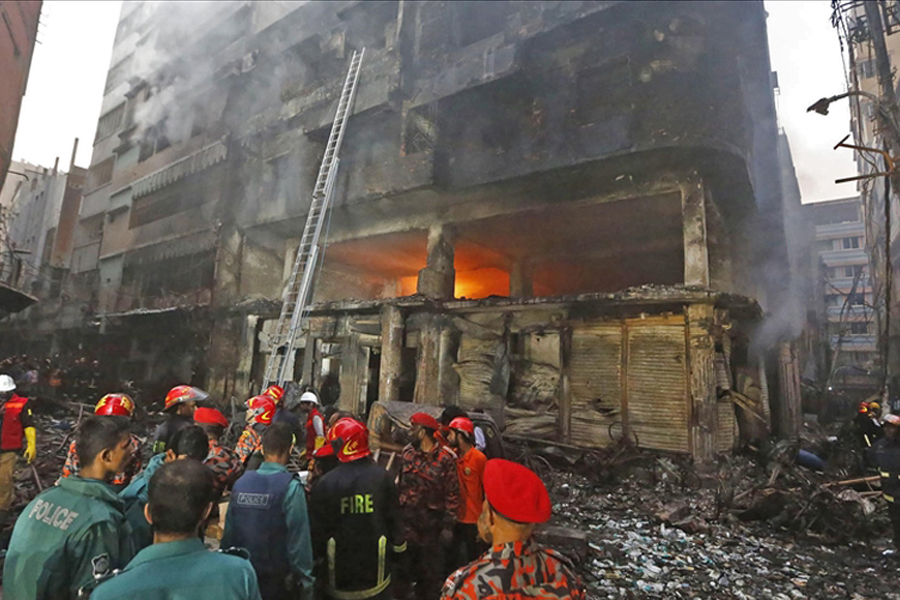
Published :
Updated :

Spring, a season of renewal and joy, brings with it a paradoxical challenge in Bangladesh. While the blooming flowers and pleasant weather uplift spirits, this season also marks the driest period of the year, accompanied by a distressing surge in fire incidents. Every year, devastating fires wreak havoc across the country, claiming lives, injuring countless individuals, and causing extensive damage to properties. The recurring nature of these tragedies underscores the urgent need for comprehensive measures to prevent fire incidents and mitigate their impact. As we welcome the beauty of spring, it is imperative to address this pressing issue with urgency and collective responsibility.
Spring in Bangladesh is characterised by low humidity, scarce rainfall, and dry weather conditions. These factors create an environment where fires can ignite easily and spread rapidly. From urban centres to rural villages, fire incidents during this season have become a grim routine. Slums, markets, factories, and residential areas are particularly vulnerable, often experiencing catastrophic losses. The recent years have seen a disturbing rise in the frequency and intensity of these incidents, with fires breaking out in densely populated areas, industrial zones, and even educational institutions.
The consequences of these fires are devastating. Lives are lost, families are displaced, and livelihoods are destroyed. The economic toll is immense, with businesses, homes, and public infrastructure reduced to ashes. Beyond the immediate damage, the psychological trauma endured by survivors and the long-term impact on communities cannot be overstated. The recurring nature of these incidents highlights systemic failures in fire prevention, preparedness, and response.
Just last Saturday, two fires broke out in the capital, Dhaka-one at the Islambag plastic factory in Old Dhaka and another in Karwanbazar. Fortunately, both fires were extinguished in their early stages, preventing what could have been catastrophic losses. However, these incidents serve as a stark reminder of the ever-present danger. Old Dhaka, with its narrow alleys and densely packed buildings, has been the site of numerous fire tragedies in the past. The area's infrastructure makes firefighting exceptionally challenging, and despite repeated pleas, hazardous factories, such as those dealing with plastics and chemicals, continue to operate in these vulnerable zones.
The irony is that while the risks are well-known, the necessary structural changes to mitigate them have not been implemented. Old Dhaka's labyrinthine streets and wall-to-wall buildings are not only obstacles for firefighting but also exacerbate the spread of fires. The presence of chemical and plastic factories in such a densely populated area is a ticking time bomb. Authorities must take immediate measures to relocate these factories to safer locations and enforce stringent fire safety regulations in the remaining establishments.
To effectively address the problem, it is essential to understand the underlying causes of fire incidents during spring. Several factors contribute to the heightened risk.
The absence of rain and the dry, windy weather during spring create ideal conditions for fires to spread quickly. Dry vegetation, wooden structures, and other flammable materials become highly susceptible to ignition.
Overloaded electrical systems, faulty wiring, and inadequate maintenance are leading causes of fires, particularly in urban areas. Illegal electrical connections and the use of substandard equipment further exacerbate the risk.
In both urban and rural areas, the use of open flames for cooking, heating, and other daily activities increases the likelihood of accidental fires. Improper storage of flammable materials, such as kerosene and gas cylinders, also poses significant dangers.
Many buildings, especially in densely populated areas, lack basic fire safety equipment, such as fire extinguishers, smoke detectors, and sprinkler systems. Fire safety regulations are often ignored or inadequately enforced.
Unplanned urban growth, overcrowded slums, and narrow streets make it difficult for fire services to access affected areas promptly. This delay often results in more extensive damage and higher casualties.
Factories and warehouses, particularly those dealing with chemicals or flammable goods, are prone to fires due to inadequate safety protocols and poor enforcement of regulations.
The recurring fire incidents during spring demand immediate and concerted action from all stakeholders, including the government, private sector, civil society, and individuals. While firefighting efforts are crucial, prevention must be the cornerstone of any strategy to address this issue. Here are some key measures that can help prevent fire incidents and minimise their impact:
One of the most critical steps is to relocate plastic and chemical factories from Old Dhaka to safer, designated industrial zones. The current situation, where these factories operate in densely populated residential areas, is a recipe for disaster. The government must prioritise this relocation process and provide incentives for factory owners to comply. Until the relocation is complete, strict monitoring and enforcement of fire safety regulations in these factories are essential.
Building codes must be updated to include mandatory fire safety measures, such as the installation of fire extinguishers, smoke detectors, and sprinkler systems. Regular inspections should be conducted to ensure compliance, and penalties should be imposed on violators. Additionally, industrial facilities must adhere to stringent safety standards to prevent accidents.
Public awareness campaigns can play a pivotal role in preventing fire incidents. Educating citizens about fire safety practices, such as proper handling of flammable materials, safe use of electrical appliances, and emergency response procedures, can significantly reduce the risk of accidental fires. Schools, community centers, and media platforms should be utilised to disseminate this information widely.
Investing in modern firefighting equipment and training for firefighters is essential to improve response times and effectiveness. Fire stations should be strategically located to ensure quick access to high-risk areas. Additionally, community-based firefighting units can be established to provide immediate assistance in emergencies.
Urban planning must prioritise fire safety by ensuring adequate space between buildings, wider roads for emergency vehicles, and the availability of water sources for firefighting. Slum areas, which are particularly vulnerable, should be upgraded with better infrastructure and access to basic services.
Communities should be encouraged to develop fire response plans and conduct regular drills. Local leaders and volunteers can be trained to act as first responders in case of emergencies. Establishing early warning systems and evacuation routes can also save lives and reduce damage.
Efforts must be made to address the issue of electrical faults, which are a leading cause of fires. This includes upgrading electrical infrastructure, conducting regular maintenance, and cracking down on illegal connections. Public awareness campaigns should emphasise the dangers of overloading circuits and using substandard electrical equipment.
In the aftermath of fire incidents, it is crucial to provide immediate support to affected individuals and families. This includes medical care, temporary shelter, and financial assistance. Long-term efforts should focus on rebuilding communities with improved fire safety measures in place.
The devastating fire incidents during spring are a stark reminder of the vulnerabilities we face as a society. While the challenges are significant, they are not insurmountable. By taking proactive measures and working together, we can prevent these tragedies and create a safer environment for all.
The government must take the lead in implementing and enforcing fire safety regulations, while the private sector and civil society must actively participate in awareness campaigns and community initiatives. Individuals, too, have a role to play by adopting safe practices and advocating for better fire safety measures in their communities.
As we celebrate the beauty and joy of spring, let us also commit to addressing the dangers that accompany this season. By prioritising fire prevention and preparedness, we can ensure that spring remains a time of renewal and hope, rather than one of loss and devastation. The time to act is now-before another life is lost, another home is destroyed, or another community is left in ruins. Together, we can build a safer, more resilient Bangladesh.
mirmostafiz@yahoo.com


 For all latest news, follow The Financial Express Google News channel.
For all latest news, follow The Financial Express Google News channel.